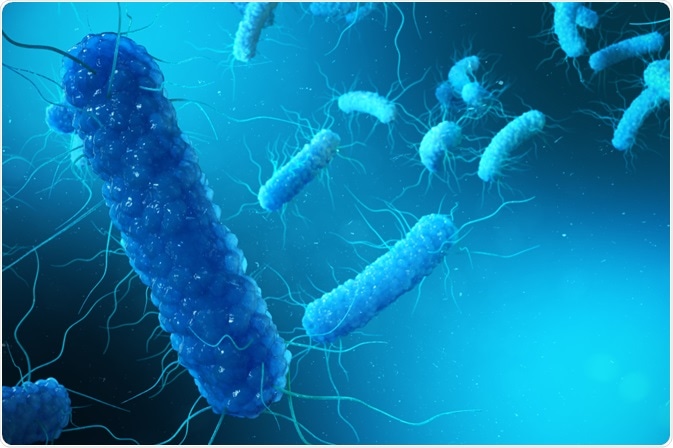Bacterial envelopes act as a barrier to protect bacterial cells against their environment. As such the integrity of the barrier is a top priority. Envelope stress responses detect damage to the envelope and can modify the transcriptome to alleviate cellular stress.

Image Credit: Rost9/Shutterstock.com
Bacterial envelopes and stress responses
The cell envelope is composed of membranes and other outer structures, such as proteinaceous S-layers. The envelope is present in both gram-negative and positive bacteria but consists of different components in these bacterial types.
It protects from environmental turbulence and chemicals, such as osmotic pressure and antibiotics.
Envelope stress responses are vital to maintain, sense, and fix damage to the envelope. One of the main types of envelope stress responses is the σE pathway. It is believed to be activated in response to faults in the assembly of β-barrel proteins which make up a significant part of the envelope.
Another is the Cpx signaling pathway, which responds to protein misfolding in the periplasm or the inner membrane. There is also the phage-shock protein response, which is important for bacterial defense against other organisms.
There is also evidence that there are sRNAs (bacterial small RNAs) that signal between envelope stress response pathways. This coincides with observations that the σE and Cpx pathways are highly interconnected.
Types and effects of envelope stress responses
Because numbers and types of cell envelopes differ between gram-negative and positive bacteria, so does the way the envelope stress responses work. The stress responses differ, but the control of these responses is relatively similar.
σE responses control several downstream factors, among which are proteins that act directly on proteins in the periplasm that have been misfolded. Other proteins it affects are involved in lipopolysaccharide synthesis.
σE is one of the stress responses that is most tied to antibiotic resistance, as its effects can be induced by common antibiotics such as vancomycin.
As σE, Cpx responses are triggered by protein misfolding, but also by high external pH and alterations to the inner membrane’s lipid composition. Cpx affects more than 100 proteins, some of which are also affected by σE.
Phage-shock protein responses are less well understood and can be triggered by a myriad of factors, including filamentous phase infection, osmotic shock, organic solvents, and extended incubation in alkaline conditions.
Envelope stress responses can have several responses to antibiotics, including detoxification, maintaining the envelope, and counteracting damage. The antibiotics they respond to are cell wall focused antibiotics.
Response systems that are responding to envelope damage are often mediators of antibiotic resistance, and often against a whole suit of drugs.
Some systems don’t respond at all to cell wall antibiotics, because they are indirectly, rather than directly, linked to envelope stress. Some of these types are critical for envelope function and integrity during normal conditions and are therefore critical to envelope health but not stress-induced by antibiotics.

Image Credit: nokwalai/Shutterstock.com
The role of small RNAs (sRNAs)
All of the main envelope stress responses utilize sRNAs as regulatory molecules. Their job is to modify gene expression profiles to allow appropriate protein production. They usually act negatively, meaning they prevent translation of an mRNA or promote its degradation or both.
The few sRNAs that act positively do so by removing RNA structures that are stopping translation.
σE responses are associated with a strong decrease in β-barrel protein levels. This is because σE sRNAs MicA and RybB which reduce its synthesis. Cpx also reduces β-barrel protein levels but inducing OmrA, OmrB, and MicF sRNAs which are involved in reducing synthesis by affecting the synthesis apparatus.
While great strides have been made in understanding envelope stress responses, questions remain. Because they are complex systems with many interacting triggers and response cascades, it is not entirely clear how multiple types of stress responses are integrated into a cohesive, protective response.
Similarly, while the network of responses is complex, it is not well understood if network interfacing between different pathways is important during stress.
Sources
- Grabowicz, M., and Silhavy, T.J. (2017). Envelope stress responses: an interconnected safety net. Trends in Biochemical Sciences. https://doi.org/10.1016/j.tibs.2016.10.002
- Jordan, S. (2008). Cell envelope stress responses in Gram-positive bacteria. FEMS Microbiology Reviews. https://doi.org/10.1111/j.1574-6976.2007.00091.x
Further Reading
- All Bacteria Content
- Does Vinegar Kill Bacteria?
- What are Extensively Drug Resistant (XDR) Bacteria?
Last Updated: May 7, 2020

Written by
Sara Ryding
Sara is a passionate life sciences writer who specializes in zoology and ornithology. She is currently completing a Ph.D. at Deakin University in Australia which focuses on how the beaks of birds change with global warming.
Source: Read Full Article





